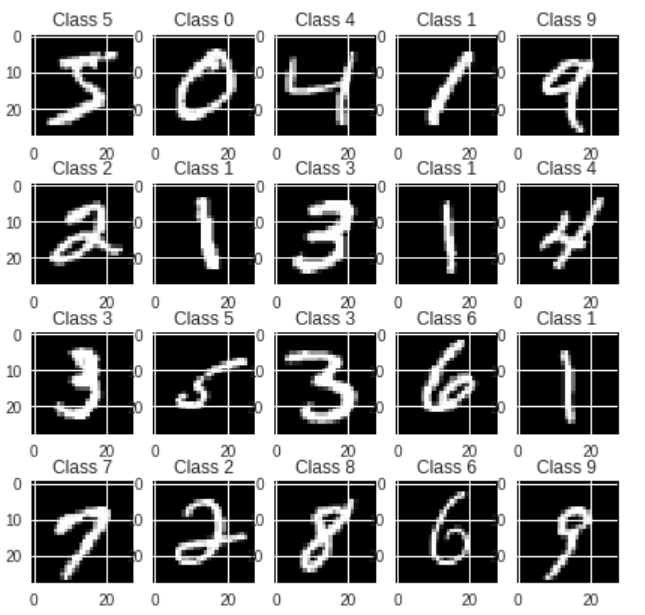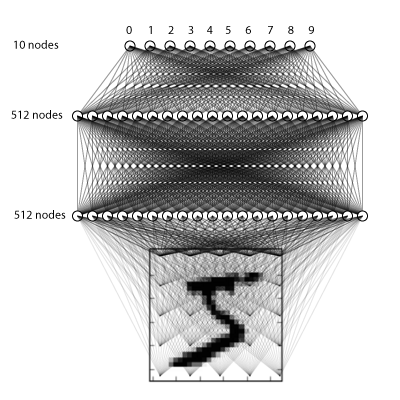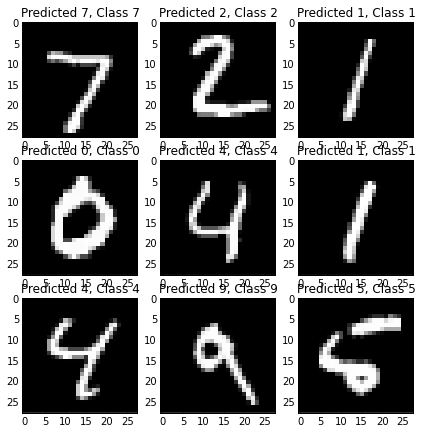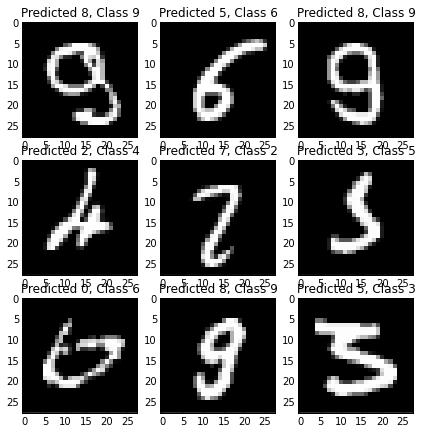MINST手写数字识别(一)—— 全连接网络
这是一个简单快速入门教程——用Keras搭建神经网络实现手写数字识别,它大部分基于Keras的源代码示例 minst_mlp.py.
1、安装依赖库
首先,你需要安装最近版本的Python,再加上一些包Keras,numpy,matplotlib和jupyter.你可以安装这些报在全局,但是我建议安装它们在virtualenv虚拟环境,
这基本上封装了一个完全孤立的Python环境。
安装Python包管理器
sudo easy_install pip
安装virtualenv
pip install virtualenv
使用cd ~进入主目录,并创建一个名为kerasenv的虚拟环境
virtualenv kerasenv
再激活这个虚拟环境
source kerasenv/bin/activate
现在你可以安装前面提到的包到这个环境
pip install numpy jupyter keras matplotlib
2、搭建神经网络
以下代码都在Google Colab中运行
2.1 导入一些依赖
import numpy as np import matplotlib.pyplot as plt plt.rcParams['figure.figsize'] = (7,7) # Make the figures a bit bigger from keras.datasets import mnist from keras.models import Sequential from keras.layers.core import Dense, Dropout, Activation from keras.utils import np_utils
2.2 装载训练数据
nb_classes = 10 # the data, shuffled and split between tran and test sets (X_train, y_train), (X_test, y_test) = mnist.load_data() print("X_train original shape", X_train.shape) print("y_train original shape", y_train.shape)
结果:
Downloading data from https://s3.amazonaws.com/img-datasets/mnist.npz 11493376/11490434 [==============================] - 0s 0us/step X_train original shape (60000, 28, 28) y_train original shape (60000,)
让我们看看训练集中的一些例子:
for i in range(20): plt.subplot(4,5,i+1) plt.imshow(X_train[i], cmap='gray', interpolation='none') plt.title("Class {}".format(y_train[i]))

2.3 格式化训练数据
对于每一个训练样本我们的神经网络得到单个的数组,所以我们需要将28x28的图片变形成784的向量,我们还将输入从[0,255]缩到[0,1].
X_train = X_train.reshape(60000, 784) X_test = X_test.reshape(10000, 784) X_train = X_train.astype('float32') X_test = X_test.astype('float32') X_train /= 255 X_test /= 255 print("Training matrix shape", X_train.shape) print("Testing matrix shape", X_test.shape)
结果:
Training matrix shape (60000, 784)
Testing matrix shape (10000, 784)
将目标矩阵变成one-hot格式
0 -> [1, 0, 0, 0, 0, 0, 0, 0, 0]
1 -> [0, 1, 0, 0, 0, 0, 0, 0, 0]
2 -> [0, 0, 1, 0, 0, 0, 0, 0, 0]
etc.
Y_train = np_utils.to_categorical(y_train, nb_classes)
Y_test = np_utils.to_categorical(y_test, nb_classes)
2.4 搭建神经网络
2.4.1 搭建三层全连接网络
我们将做一个简单的三层全连接网络,如下:

model = Sequential() model.add(Dense(512, input_shape=(784,))) model.add(Activation('relu')) # An "activation" is just a non-linear function applied to the output # of the layer above. Here, with a "rectified linear unit", # we clamp all values below 0 to 0. model.add(Dropout(0.2)) # Dropout helps protect the model from memorizing or "overfitting" the training data model.add(Dense(512)) model.add(Activation('relu')) model.add(Dropout(0.2)) model.add(Dense(10)) model.add(Activation('softmax')) # This special "softmax" activation among other things, # ensures the output is a valid probaility distribution, that is # that its values are all non-negative and sum to 1.
结果:
WARNING:tensorflow:From /usr/local/lib/python3.6/dist-packages/tensorflow/python/framework/op_def_library.py:263: colocate_with (from tensorflow.python.framework.ops) is deprecated and will be removed in a future version. Instructions for updating: Colocations handled automatically by placer. WARNING:tensorflow:From /usr/local/lib/python3.6/dist-packages/keras/backend/tensorflow_backend.py:3445: calling dropout (from tensorflow.python.ops.nn_ops) with keep_prob is deprecated and will be removed in a future version. Instructions for updating: Please use `rate` instead of `keep_prob`. Rate should be set to `rate = 1 - keep_prob`.
2.4.2 编译模型
Keras是建立在Theano(现在TensorFlow也是),这两个包都允许你定义计算图,然后高效地在CPU或GPU上编译和运行,而没有Python解释器地开销。
当编译一个模型,Keras要求你确定损失函数和优化器,我使用的是分类交叉熵(categorical crossentropy),它是一种非常适合比较两个概率分布的函数。
在这里,我们的预测是十个不同数字的概率分布(例如,80%认为这个图片是3,10%认为是2,5%认为是1等),目标是一个概率分布,正确类别为100%,其他所有类别为0。交叉熵是度量两个概率分布差异程度的方法,详情wiki。
优化器帮助模型快速的学习,同时防止“卡住“和“爆炸”的情况,我们不讨论其太多的细节,但是“adam”是一个经常使用的好的选择。
model.compile(loss='categorical_crossentropy', optimizer='adam')
2.4.3 训练模型!
这是有趣的部分:你可以喂入之前加载好的训练集到模型,它将学习如何分类数字.
model.fit(X_train, Y_train, batch_size=128, epochs=4, verbose=1, validation_data=(X_test, Y_test))
结果:
Train on 60000 samples, validate on 10000 samples Epoch 1/4 60000/60000 [==============================] - 10s 171us/step - loss: 0.0514 - val_loss: 0.0691 Epoch 2/4 60000/60000 [==============================] - 10s 170us/step - loss: 0.0410 - val_loss: 0.0700 Epoch 3/4 60000/60000 [==============================] - 11s 177us/step - loss: 0.0349 - val_loss: 0.0750 Epoch 4/4 60000/60000 [==============================] - 11s 184us/step - loss: 0.0298 - val_loss: 0.0616 <keras.callbacks.History at 0x7f531f596fd0>
2.4.4 最后,评估其性能
score = model.evaluate(X_test, Y_test, verbose=0) print('Test score:', score)
效果:
Test score: 0.061617326979574866
检查输出,检查输出并确保一切看起来都很合理,这总是一个好主意。接下来,我们看一些分类正确的例子和错误的例子.
# The predict_classes function outputs the highest probability class # according to the trained classifier for each input example. predicted_classes = model.predict_classes(X_test) # Check which items we got right / wrong correct_indices = np.nonzero(predicted_classes == y_test)[0] incorrect_indices = np.nonzero(predicted_classes != y_test)[0]
plt.figure() for i, correct in enumerate(correct_indices[:9]): plt.subplot(3,3,i+1) plt.imshow(X_test[correct].reshape(28,28), cmap='gray', interpolation='none') plt.title("Predicted {}, Class {}".format(predicted_classes[correct], y_test[correct])) plt.figure() for i, incorrect in enumerate(incorrect_indices[:9]): plt.subplot(3,3,i+1) plt.imshow(X_test[incorrect].reshape(28,28), cmap='gray', interpolation='none') plt.title("Predicted {}, Class {}".format(predicted_classes[incorrect], y_test[incorrect]))
结果:


总之,这是一个完整的程序,在Keras主页http://keras.io/和githubhttps://github.com/fchollet/keras有其它许多优秀的例子。

